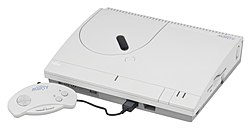 | |
 FM Towns Marty console with controller | |
| Manufacturer | Fujitsu |
|---|---|
| Type | Home video game console |
| Generation | Fifth |
| Release date |
|
| Introductory price | ¥98,000 (then c. US$710) [1] |
| Discontinued |
|
| Units sold | 45,000 (by December 31, 1993) [2] |
| Media | CD-ROM, 3+1⁄2-inch floppy disks |
| Operating system | Towns OS |
| CPU | AMD 386SX at 16 MHz |
| Memory | 2 MB |
| Display | 352×232 – 640×480 resolutions, 256 colors on-screen out of a palette of 32 768; TV composite and S-Video output |
| Graphics | Fujitsu custom graphics chip |
| Sound |
|
| Backward compatibility | FM Towns |
The FM Towns Marty [a] is a home video game console released in 1993 [3] by Fujitsu, exclusively for the Japanese market. It uses the AMD 386SX, a CPU that is internally 32-bit [1] but with a 16-bit data bus. The console comes with a built-in CD-ROM drive and disk drive. It was based on the earlier FM Towns computer system Fujitsu had released in 1989. The Marty was backward-compatible with older FM Towns games.
Contents
In 1994, a new version of the console called the FM Towns Marty 2 (エフエムタウンズマーティー2, Efu Emu Taunzu Mātī Tsū) was released. It featured a darker gray shell and a lower price (¥66,000 or US$670), but was otherwise identical to the first Marty. It was widely believed that the FM Towns Marty 2 would feature similar improvements to the FM Towns 2, which had a swifter CPU than the first, but this was not the case. [4] It has also been speculated that the Marty 2 featured an Intel 486 CPU, but this was also discovered to be false.
There is also the FM Towns Car Marty (エフエムタウンズカーマーティー, Efu Emu Taunzu Kā Mātī) for installation in automobiles. It included a built-in navigation system with audio and video guidance, and could also be detached from the car and played at home. [5] An optional IC Card for the FM Towns Car Marty allowed it to use VICS, [5] and was subsequently sold with a video monitor.
